#MinutiaMenCelebrityInterview EP64 Rick and Dave chat with Geico Caveman, John Lehr https://t.co/zWPkSXlFT0
— Radio Misfits (@RadiosMisfits) April 2, 2021
Musings, observations, and written works from the publisher of Eckhartz Press, the media critic for the Illinois Entertainer, co-host of Minutia Men, Minutia Men Celebrity Interview and Free Kicks, and the author of "The Loop Files", "Back in the D.D.R", "EveryCubEver", "The Living Wills", "$everance," "Father Knows Nothing," "The Radio Producer's Handbook," "Records Truly Is My Middle Name", and "Gruen Weiss Vor".
Friday, April 02, 2021
The Geico Caveman
Even More Media Consolodation is on the Way
From the New York Times this morning...
The Supreme Court unanimously ruled on Thursday that the Federal Communications Commission could relax rules limiting the number of newspapers, radio stations and television stations that a single entity may own in a given market.
The decision is likely to prompt further consolidation among broadcast outlets, some of which say they need more freedom to address competition from internet and cable companies. Critics fear that media consolidation will limit the perspectives available to viewers.
Consider me one of those critics. This is the LAST thing we need right now. We'll be down to one or two owners of ALL media in no time. Think that could be dangerous at all?
Thursday, April 01, 2021
George Will Quiz
Every year I think I'm going to do better on his Opening Day quizzes. This year I only got 18 out of 37. https://t.co/tG107YRafp
— Rick Kaempfer (@RickKaempfer) April 1, 2021
I'm Ready
Happy Opening Day! Baseball season is here and this time with the most important part....the FANS! Enjoy everyone! pic.twitter.com/BqEtzRGtsG
— RyanDempster (@Dempster46) April 1, 2021
Jon Hansen
The latest issue of Illinois Entertainer is out and features my interview with WCIU-TV's Jon Hansen.
Wednesday, March 31, 2021
30 Years of Media Writing
Just posted on the Eckhartz Press Studio Walls blog...
Eckhartz Press co-publisher Rick Kaempfer is a former radio producer and host who still writes about the media regularly as the media columnist for Illinois Entertainer. This is his 30th year as a media writer, so throughout the year we are featuring excerpts from the more than 200 current and former Chicago radio and television stars he has interviewed, including many people who are celebrating birthdays this month. Here are ten examples…
US-99’s Drew Walker celebrated a birthday on March 8th. Drew has been holding down the fort at US-99 for many years now, but Rick interviewed him shortly after he was given his first full time shift in 2007. Rick noted his admiration for the way the country music industry and country radio have figured out a way to work together productively. Drew agreed.

We are on the same team – country radio / country artists / country listeners. Artists recognize how much of their success is owed to their fans. The fans connect to them through their local radio stations, the stations connect to the artists directly, and we serve as a liaison. Yes, there are other mediums to deliver music, but not in the way we do. A quick example. This year is the station’s 25th anniversary of broadcasting country music in town. One of our very special birthday events just took place. Brad Paisley, a superstar, flew into the DuPage County Airport at lunchtime. Stepped off his jet, picked up a guitar, did a 45-minute acoustic set for 100 listeners in an airplane hangar, a quick Q&A, and then back on the plane to Nashville. I truly believe our listeners hear that we care about them, and that the artists do as well. It is very much a relationship that we value.
Read the entire Drew Walker interview here.
The Score’s overnight host Les Grobstein celebrated a birthday on March 11th. Rick interviewed Les back in 2009, and asked him to recount the famous tale of the day Larry Lujack and Steve & Garry almost got into a fight on the air. Les was in the WLS studio at the time.
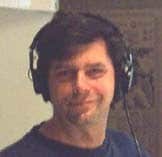
I thought I was going to have to break up a fist fight. It was Thanksgiving eve, the Wednesday night before Thanksgiving, and the office was almost totally empty. Steve was ripping Larry on the air, which he did nearly every day. Garry had a broken foot. Larry was hanging out at the station, which is something he did on occasion, long after his show was over. Well, Larry walked into the studio and wished Steve & Garry a happy Thanksgiving. It was very tense. They went back and forth, and back and forth, and one of Steve’s kids was there, and he started crying. After that, Larry left. After Larry was gone, Steve said “If he ever comes back in here, I’ll break both of his legs.”
Well, things continued in the days to come. I flew to Miami for the Dolphins-Bears game (1985), because Steve & Garry were doing the show from Miami Beach. I got a lot of Bears players live on the air with Steve and Garry. We had Fridge, Fencik, etc. So anyway, I’m doing a sportscast from there, and at the end of the sportscast, Larry came on from Chicago to say “Hey Les, did you hear about my new feature? It’s called ‘Whose afraid of the big fat pig? The truth about to Steve Dahl.’ Needless to say, this got back to Steve.
So, we’re back in the studio in Chicago, and I’m doing my sportscast, talking about the Bears, when all of a sudden the door opens and Larry comes in and my mic is still open and I say “Lar, why couldn’t you do this when Jim Johnson was in here?” Of course, he came in while I was there on purpose because I was on both of their shows. Jim was a Steve & Garry partisan, but I wasn’t allowed to choose sides. Steve says “Larry get out.” But Larry says, “I heard what you said the other day, so I just wanted to see if you’re going to break both my legs before I throw your head through the wall.” It wasn’t a bit. It wasn’t fake. Then Larry says he is going to promote his new feature, so Steve and Garry leave the studio, and Steve says “Let’s leave Mr. Insane alone in his insane world.” Garry, who has a broken leg remember, hobbles out of the studio. Lujack sits down at the console and says “So, I guess I’m finishing the show. He said ‘Les, we were talking about football, right?’ I did the sign off and got the f*** out of there.
About ten minutes later three Chicago coppers got off the elevators and most of the employees were gone. I greeted the cops and they said they got a report that a riot had broken out at WLS, and I told them there was nothing to worry about. The next morning I was in studio with Larry for what was supposed to be the “Whose afraid of the big fat pig” thing, but he didn’t do it. He said that he and Steve had a nice chat and had resolved their differences. Of course, within two days Steve was ripping him again and the war stayed on for the rest of their time there.
Read the entire interview here.
Rich Koz, the mastermind behind Svengoolie, celebrated a birthday on March 12th. His television show is beloved in Chicago (WCIU-TV), and it’s now also a national show. Rick interviewed Koz about Svengoolie, but he also talked about his early days in Chicago radio (pre-Svengoolie) when he worked with the legendary voice-over man (Chickenman) Dick Orkin…
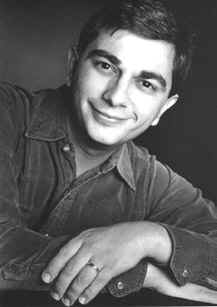
When Dick was doing a huge package of different features for the Bicentennial (yes, THAT long ago)- he brought me in to write one of the features- and, I did well enough that he had me write or co-write several others, as well as doing various voices on them. This evolved into me also writing and doing commercials, and other features- so, when he was going to do “Chickenman Returns for the Last Time Again”- the series where the Winged Warrior opened a crime fighting school, with one student- and he asked me to write some of the episodes, I was in heaven!
In junior high, I used to listen to the original series, and think “I’d like to do that some day.” I never realized that I actually would! Working with him was a real “learn as you earn” situation- I learned a lot by just hanging around him, as far as writing, voice work, double-tracking characters, etc.- being able to take his lead on coming up with adventures for Chicken Man was a real honor. Near the end of the series, we needed some more plots, and I made a list of ideas for him- remember, the original series had gone on for quite a long time- and I remember him going through the list, and saying- “no, we did this- we did this – we did this one, too!” There were a lot of the episodes I had never heard, I guess. Funny that I managed to think of stuff he had already thought of!
Dick has such a great sense of humor, and can do that low-key yet hilarious stuff so perfectly. He always knew how to keep the funny stuff spread through the whole spot, and still get the sponsor’s message out. I love the fact that he could also come at the situation from a totally unexpected direction- and, he’d start some ads like you were eavesdropping on a conversation already in progress. Plus, he had a way of continuing on after the final punchline that was just frosting on the cake. He was a very kind gentleman, had no huge ego in spite of his great talent, and boy, did he know his stuff.
Read the entire Rich Koz interview here.
Former AM Loop (and WCKG) star Kevin Matthews celebrated a birthday on March 12th. Rick has interviewed Kevin several times. The first time was during Kevin’s heyday at the Loop in 1993. During one of the interviews, Rick asked Kevin about his radio influences…

Honestly, I listened to my brother’s 8-tracks in his Torino, and didn’t really listen to radio that much. It wasn’t until I saw American Graffiti and saw Wolfman Jack that I got a feel for what radio could be. The Wolfman—he was wild! I started at a college station and we were wild too. Our advisor dropped acid and would do two days shows—I swear that station was like the Manson Ranch. But it was so much fun. I learned about music there—everything from John Coltrane to the Sex Pistols. My roommate and I did a show we called the Dos Equis hour. We brought in a case of Dos Equis, drank it live on the air, and played Spanish songs. It was so much fun—probably too much fun. We lost our license when we said that President Lubbers (the President of the University) had been mutilated and killed. They came in like Animal House, took away the license, and turned it into a hair salon. That’s where it started for me. My first station–and we lost our license.
Read the entire interview here.
Former WGN Morning man Steve Cochran celebrated a birthday on March 14th. Rick has interviewed Steve many times, and at several radio stations. The most recent interview took place in 2017. Cochran looked back at his first stint at WGN, and was able to tell Rick what it was like to work in that unusual situation…

That 2007-2010 period when Sam Zell came in and brought in the folks from the Star Wars bar, things really got weird. Radio was a slowly digressing business and radio folks were trying to figure out how to keep people involved, but we scared people away with some of the horrible moves that were made. Listeners just left, that frankly, we’re still trying to get back. Some may never come back. All the goodwill that WGN had built up forever was just pissed away. You put on the former city clerk at night and some French advertising guy from Cleveland on the weekends. It was one horrific idea after the other. I told them ‘You guys are on some sort of a Joe DiMaggio streak of bad moves here.’
Read the entire interview here.
Chicago sportscaster (WGN-TV, WBBM-TV, & WBBM-Radio) Rich King celebrated a birthday on March 18th. After a long and storied career in Chicago television, he retired in June of 2016. Rick interviewed him during his final week on the air…
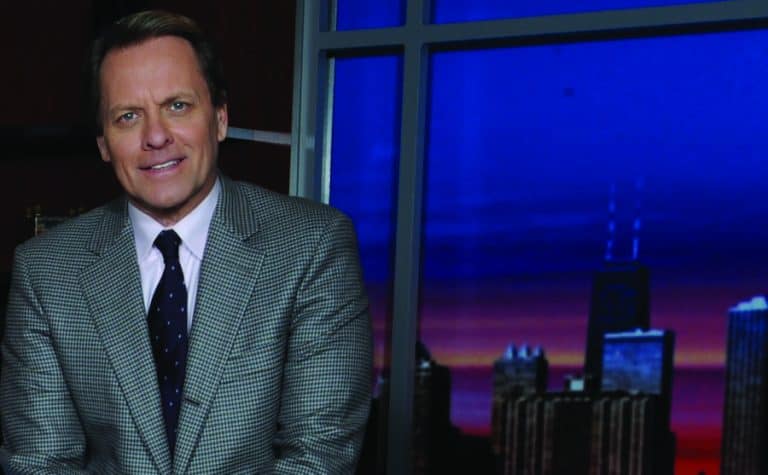
It’s been fantastic. The Blackhawks sent me a nice jersey. My friends in the business have been very complimentary. I have so many friends in the business. The only negative in this whole thing is that I won’t see these great people as much as I do now. That’s the only thing I will miss.
You look back on your career and remember some of the things you’ve been able to do – to cover the great athletes like Michael Jordan and Walter Payton. To meet such great people like Jerry Reinsdorf and Tony LaRussa. Those are the things that go through your mind. How did I ever get this far? I came from the neighborhood of Pilsen, which was a very poor neighborhood when I was a kid, and we didn’t have anything really. And here I am rubbing elbows with the all-time greats. If you would have told me that when I was just coming up in the business, I never would have believed it. Working with Johnny Morris, Brad Palmer, Dan Roan. It’s just way beyond my wildest dreams.
Read the entire interview here.
Legendary rock jock Mitch Michaels celebrated a birthday on March 20th. Mitch was one of the voices of the Loop during it’s heyday in the late 70s/early 80s, and worked at just about every other station on the dial. He currently holds down a shift on the River in Aurora. Rick interviewed Mitch several times, most recently in 2015 for the Illinois Entertainer. Mitch recalled those heady days at the Loop…

Those first few months we just exploded. I lived in Oak Park at the time, and I’ll never forget one day on my way into the station, I was cranking the Loop. I turned it down at the stoplight, but I still heard the station. The car next to me was playing it. The car on the other side was listening to the Loop. Everyone was. We were everywhere. Those black t-shirts were part of it. The logo. The promotions. The incredible Lorelei commercials. The music was great. It just all meshed and hit. You couldn’t go anywhere without seeing a Loop t-shirt. Disco Demolition was probably the greatest radio promotion ever. The Sox weren’t drawing. I remember sitting in the GM’s office with Jesse Bullett, and Jeff Schwartz, and Mike Veeck. We all wrote a number on the board predicting how many people this promotion would draw. I think the biggest guess was 27,000. Because of those projections, Veeck didn’t have nearly enough security, and it was crazy. That exploded the station even more.
Read the entire interview here.
Radio Hall of Famer John Records Landecker celebrated a birthday on March 28th. He has been a big part of the Chicago media scene since he arrived in town in 1972. (Full disclosure: Rick produced John’s show for ten years at WJMK, and co-wrote his book Records Truly Is My Middle Name). In 2020, John returned to the airwaves at WGN and talked to Rick about this new chapter in his life…

I knew that I did not want to be confrontational or political. I didn’t want to be discussing rioting with aldermen, or finances with Terry Savage, or medical developments with some doctor from Northwestern on a regular basis—if at all. I wanted to stay away from the stories that are causing people to grind their teeth—the grim reality everyone deals with every day. And I was thinking that a lot of people are driving while they listen, and when you drive down the toll road, and you run into an oasis, you know that you can stop there and relax. You can leave the pressure of driving behind. Have a cup of coffee or something, go to the bathroom, chill out and take it easy, if just for a short time. When you’re in the desert, and you see an oasis, you know you can get water, even though you’re still in the desert. This is the radio version of that. I’m trying to be fun in the middle of un-fun. I don’t think there’s really anything like this on the radio anywhere these days.
Read the entire interview here.
Chicago radio legend Fred Winston celebrated a birthday on March 30. Fred was a big star on the biggest stations in Chicago, including WLS and WCFL (among others). Rick interviewed Fred a few times, including this most recent interview for the Illinois Entertainer in 2018. He is enjoying his post-radio life…
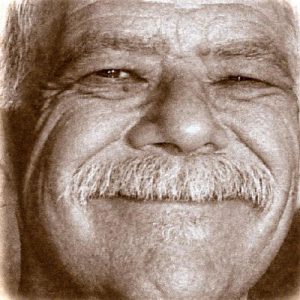
I guess I am retired, although I don’t feel like it’s done. I’m always reticent to say that I’m done now because I do feel like I could drop back behind the mic and with a little DW40 in the mouth, I could pick up where I left off. But I’m busier than ever these days. I have a small farm here that has enough crap going on to keep me busy every day. I’m in Berrien County which is the highest point of elevation in this region, so if it farts on Lake Michigan, I get it here. We’re currently in the throes of a major blizzard. We’ll have an additional two feet of snow in the next three days. The frustrating thing about being a gentleman farmer, as you call me, are the many tiny engines that need spark plugs and oil changes. Rather than flap my mouth, I now bang my knuckles. I don’t really miss radio the way it was (is) when I last did it. We were told that’s the way the business has evolved. People just don’t want to hear you speak for more than eight seconds. It’s not about you. It’s about the music, man. ‘Hey, I dug that break about the Doobies, man.’ I thought ‘Aw shit, what have I gotten myself into?’
Read the entire interview here.
WGN-TV and WGN-Radio personality Dean Richards celebrated a birthday on March 31. Rick interviewed Dean in 2008 about his storied career, including his key role on the current (yes, still on the air all these years later) WGN-TV Morning Show…
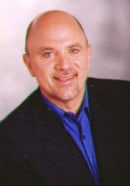
It’s a crew of incredibly talented people in front of and behind the cameras ; all working to make great TV everyday. Our morning show reminds me in a way of the TV show “M*A*S*H.” It’s a bunch of constantly exhausted, irreverent, talented people, who know when to be serious and know when it’s O.K. to goof around. There’s an honesty to our show that seems to make it so refreshing. We all contribute. We all are heard but Larry, Robin and Paul set the tone around which everything else must flow. Our producers and writers are amazing. My producer, Tyra Martin, is a Godsend. Segment producer, Jeff Hoover is the class clown who comes up with some of the show’s funniest bits. It’s really like a family, sometimes dysfunctional, all working toward the same goal. Plus, it’s really unusual to have such great talent who happen to also be great people in real life. We’re all friends and have each other’s backs.
Tuesday, March 30, 2021
Free Excerpt: Walt Frazier (From Signature Shoes)
Free Excerpt: Walt Frazier (Signature Shoes)
Posted on
Basketball legend Walt Frazier celebrated a birthday this week. He is featured prominently in the Eckhartz Press book Signature Shoes by Ryan Trembath. In honor of Frazier’s birthday, we’re posting a free excerpt about him and his famous signature shoe.
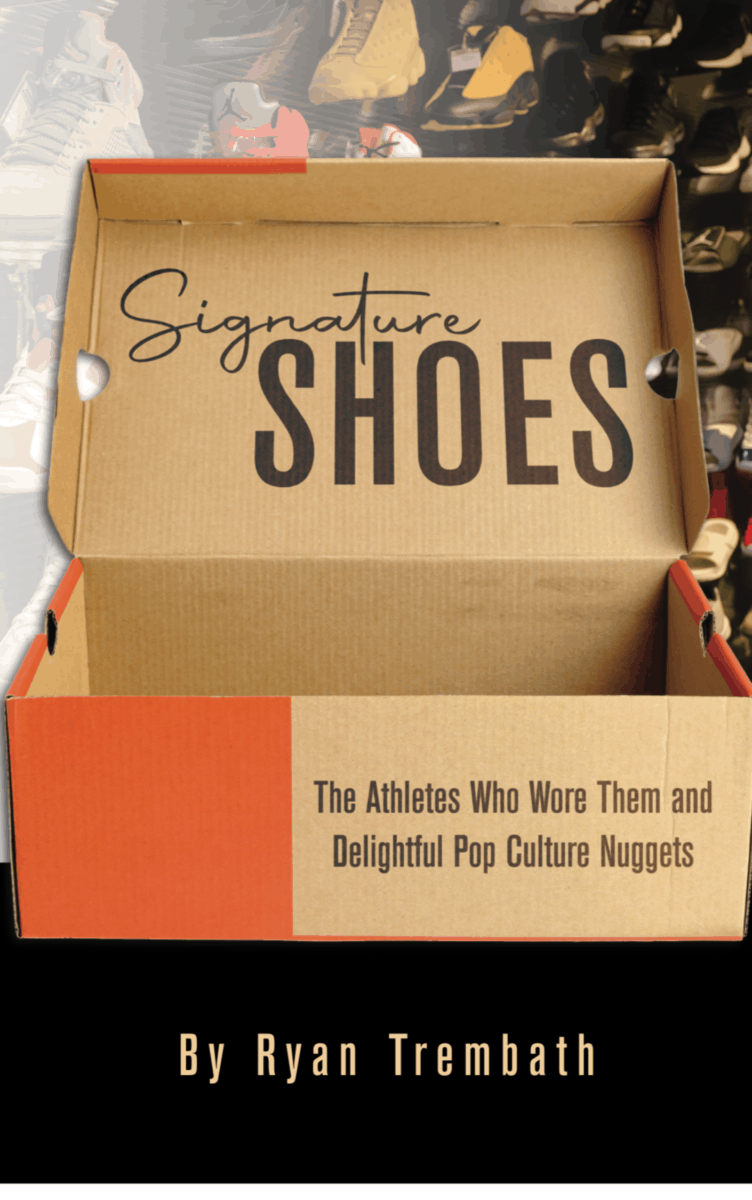
Walt “Clyde” Frazier made his professional debut in 1967 after he was drafted 5th overall by the New York Knicks of the NBA at the age of 22. Frazier had a very distinct sense of fashion, which included a penchant for wearing a mink coat and a wide brim hat like Warren Beatty’s Clyde Barrow.[1] It is rumored that Knicks teammate Dick Barnett taught Frazier how to dress (Monroe & Troupe, 2013). Some accounts have Frazier acquiring the nickname Clyde because of his prowess for stealing the basketball, but I haven’t necessarily found that to be true, and frankly, I like the hat story better. By 1973, Frazier had two NBA titles to his name and a signature shoe to go along with them – the Puma Clyde. It has been disputed that it was Frazier and not Jabbar, who was the first NBA player with a shoe contract, which, according to the book “Hard Labor,” he supposedly signed with Puma in 1971, and became the first player with a sneaker contract and shoe – the Clydes (Smith S. , 2017). Puma’s own website claims that the Clyde didn’t come out until 1973 (Puma, 2019), but Frazier’s account states otherwise: “Puma came to me, and I think my first deal was $5,000 – all the shoes I could wear. And then right after that, we won the championship, so they came out with the suede versions.” According to Barbara Smits’ “Sneaker Wars,” Frazier signed for the exact same deal that Namath had. However, Frazier made a lot more money than Namath because his shoe became a cultural phenomenon. Smit estimates that over one million pairs of the Clyde were sold in the ’70s alone (Smit, 2008). This claim is supported in the book “Slam Kicks” which reaffirms that the Clyde didn’t appear until 1973. “Slam Kicks” states that “The Puma Clyde was the first sneaker also designed to make a fashion statement. Previously, canvas was the basketball-shoe mainstay material, and in 1973 leather was just becoming popular, and suede was simply not worn” (Osborne, 2013). The claim that suede wasn’t worn at the time supports the theory that the Clyde didn’t come out until 1973 and the Puma Suede which of course was made of suede was not very successful when it came out in 1968. It wasn’t until later when the B-boys would take the Suede and Clyde to the next level.
There are various accounts on when the Clyde made its debut. It’s more than possible that the Clyde was manufactured for Frazier in 1971 but didn’t become available to the public until 1973. Grainy game footage exists from late in the 1971-72 season which features Frazier wearing the Pumas, but none from the 70-71 season. The most likely scenario involves Frazier wearing Suedes or the Puma Basket in 71-72 with the Clyde making its debut after the ’73 Championship. Whenever it was that the shoe made its first public appearance for consumption, Frazier likely asked Puma for a custom-made pair of Suedes that featured his name. However, Frazier claims the Clyde was actually modeled after the Puma Basket, which also appeared alongside the Suede in 1968. The Basket is extremely similar to the Suede, although more durable, making it slightly heavier and less flexible (Unorthodox Styles, 2005). Many people surmise that Frazier was the first NBA player with a shoe contract, but George Mikan and Bob Cousy, as well as Jabbar, would have most likely preceded him.
Frazier discussed his Puma collection in 1974, saying, “I have all different color combinations of Puma Clydes. I have pairs for practice and pairs for games. I guess during the season I use about 20 pairs. Whenever I feel I’m not getting good traction, or they feel loose, you know, I change.” (Frazier & Berkow, 1974). The Clyde doesn’t stray very far from the design of the Puma Suede, save for no Puma logo on the heel and a thinner, somewhat wider sole. According to (Unorthodox Styles, 2005), “A basic design with clean styling was counterbalanced by a whole series of colors… finding the most original colorway and matching the laces became a popular pastime, and making the shoes look wide with fat laces was a must.” Frazier, however, didn’t find it necessary to mix and match laces, saying, “When I wore a different style sneaker, I used to wear Knicks-color strings, orange on one shoe and blue on the other. Something different than conventional white. I don’t usually wear strings like that on my Pumas. The sneakers are colorful already. But I see some kids with different-color shoestrings on Pumas. They look good” (Frazier & Berkow, 1974). Frazier, like most players, wore Converse before he switched to Puma.
In the early 70’s the Clyde became one of the principal shoes for B-boys, as they are more commonly known, because they were dancing to the breaks[2] in disco music. DJ Kool Herc is by and large considered the father of hip-hop, because he was the first to take the breaks and blend it with the break in another similar sounding song. The technique was taken to another level in 1973 when Herc started using two turntables to switch between multiple breaks, extending them into a longer piece to keep people dancing, basically making an entirely new song (Serrano, 2015). Perhaps the most famous break, at least early in hop-hop, is from Chic’s song “Good Times” which would spawn “Rapper’s Delight”[3] by the Sugarhill Gang, both of which came out in 1979.
By 1970, Frazier had his first title with the Knicks, at the expense of the Los Angeles Lakers,[4] a team that included Jerry West, Wilt Chamberlain, and Elgin Baylor. At the time, the Clyde persona was already becoming a symbol of fashion in New York (Smith S. , 2017). Frazier didn’t mess around either, spending almost half of his first year’s salary with the Knicks on clothes alone. Having grown up poor, Frazier expressed a desire to dress well, and he once told GQ magazine, “I would go out, buy clothes, go to my room, dress up, and look in the mirror and say, well I ain’t playing good but I still look good!” (Sims, 2016).
After spending the first ten years of his career with the Knicks, in 1977, Frazier was traded to the lowly Cleveland Cavaliers, where he would only appear in 66 games over the course of the next three seasons. As his career was winding down, Spalding released the Spalding Clyde in 1979. They were virtually identical to his Puma signature shoe, save for the wing logo and the tagline “Wings for your Feet” (Garcia, 2013). The seven-time all-star and two-time NBA Champion was inducted into the Hall of Fame in 1987 and honored in 1996 as part of the NBA’s 50th Anniversary All-Time Team. Frazier currently serves as a broadcaster for the MSG Network, home of the Knicks, where he has been known to entertain viewers with tales of his iconic fashion sense.
[1] “Bonnie and Clyde” – 1967
[2] Short instrumental music interludes, usually drum and bass heavy. The “B” in B-Boy stands for breaks
[3] Considered the first rap song heard by ears around the world, it would peak at #36 in the U.S. on the Billboard Hot 100. Debbie Harry and Blondie get a lot of credit for their 1981 song “Rapture,” which is the first song with rap elements to make it to #1 on the Billboard Hot 100.
[4] The Knicks would again best the Lakers in ’73, but Baylor had retired in 1971.
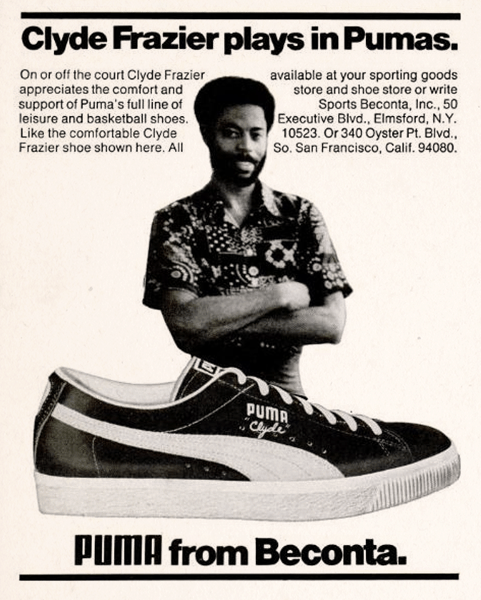
Minutia Men
.@MinutiaMen EP222 Flamshooters and Flim-Flams https://t.co/J1ZdSSHmkd
— Radio Misfits (@RadiosMisfits) March 30, 2021
1973 Deja Vu
This upcoming #Cubs season reminds me of the 1973 season of my youth. My long-time heroes @fergieajenkins, Ron Santo, Billy Williams, Glenn Beckert, Randy Hundley, and Don Kessinger were still on the team. Within the next year or two all of them were gone. Long darkness followed.
— Rick Kaempfer (@RickKaempfer) March 30, 2021
Monday, March 29, 2021
The Sense and Nonsense of Ballpark Traditions
This got me in the mood for the baseball season: The Sense and Nonsense of Ballpark Traditions.

